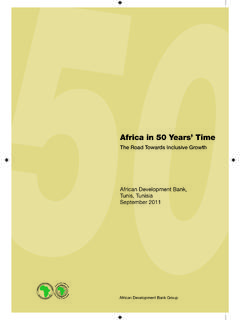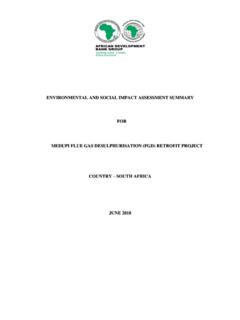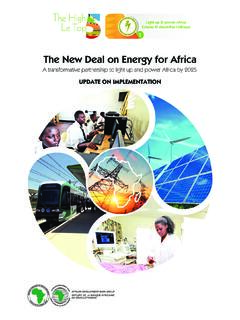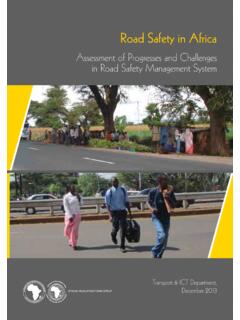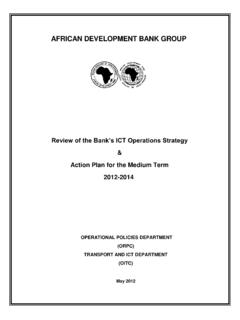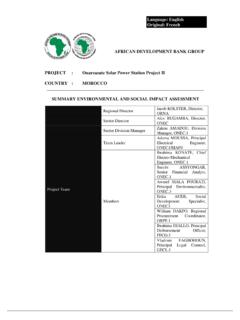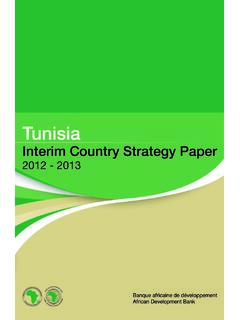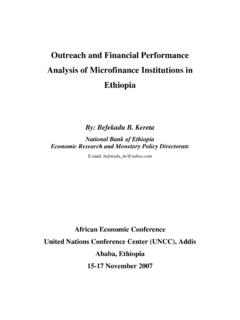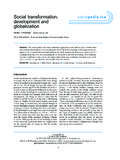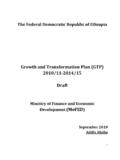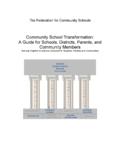Transcription of INVESTING IN GENDER EQUALITY FOR AFRICA’S …
1 QUALITY ASSURANCE AND RESULTS DEPARTMENTGENDER AND social development MONITORING DIVISIONINVESTING IN GENDER EQUALITY FOR africa S TRANSFORMATIONAFRICAN development BANK GROUPACKNOWLEDGEMENTSThis report is prepared under the auspices of the Office of the Special Envoy on GENDER of the African Bank Group. The Strategy was prepared by a team led by Ginette-Ursule Yoman, Manager of the GENDER and social development Monitoring Division. The core team for finalising the Strategy consisted of May Babiker, Awa Bamba, Gisela Geisler, Wangui wa Goro, Amel Hamza, Komal Hassamal, Mateus Magala, Linet G. Miriti, and Egidia Rukundo. The GENDER Strategy Task Force, chaired by Marlene Kanga, provided important guidance and inspiration. Its members were Cecilia Ambert, Rachel Aron, Marc Cohen, Ebrima Faal, Yacine Fal, Odile Keller, Mateus Magala, Petra Menander, Simon Mizrahi, Maria Jose Moreno, Rakesh Nangia, Ginette Nzau-Muteta, Sunita Pitamber, Agnes Soucat, and Desire Vencatachellum.
2 Important contributions were also made by Namawu Alolo Alhassan, Aly Abou-Saaba, Rita Ba, Sylvie Bara, Shirley Chinien, Sarah Cooper, Medjomo Coulibaly, Yeshiareg Dejene, Elena Fererras-Carreras, Kapil Kapoor, Josephine Ngure, Mohamed Manai, Gilbert Mbesherubusa, Zondo Sakala, Dana Elhassan, Richard Schiere, Cornelius Nkoanyane Sebutsoe, Mona Sharan, Agnes Surry, Foday Turay, and Georg Weiers. We acknowledge the support of the many Bank staff who participated in the on-line questionnaire on the GENDER Strategy in the fall of 2012. We owe special thanks to the consultants who worked on the two diagnostic studies on which the strategy is based: Mark Blackden, Kathleen Barnett, Elsa Dawson, Phillipa Hadden, Daniel Kirkwood and Emily Richardson. We acknowledge with thanks the consultations with government officials from the Bank s regional member countries and with representatives of civil society and nongovernmental organisations.
3 We acknowledge the contribution of SGLS for translation, Marie Renault for editing and Nadim Guelbi ( ) for graphic design and layout of this Strategy. FOREWORD 1 EXECUTIVE SUMMARY 2 INTRODUCTION 6 GENDER EQUALITY in africa s transformation : A vision 7 The status of GENDER EQUALITY in africa 8 The status of GENDER EQUALITY in the Bank 10 The Bank s experience and lessons learnt 11 THE GENDER STRATEGY 2014 2018 14 Objectives 14 The external strategy 14 The internal transformation strategy: the Bank we want 20 IMPLEMENTING THE STRATEGY 23 Operational approaches for better results 23 Partnerships 25 Financial and human resources 26 Monitoring and evaluation of results 26 CONCLUSION 29 References 30 ContentsLIST OF FIGURESF igure 1: The interface between the Bank s Ten-Year Strategy 2013 22 and the GENDER Strategy 2014 18 15 Figure 2.
4 Addressing women s legal status and property rights through the Bank s strategic priority areas 16 Figure 3: Addressing women s economic empowerment through the Bank s strategic priority areas 17 Figure 4: Building knowledge about and capacity in GENDER EQUALITY through the strategic priority areas 19 Figure 5: Framework for the GENDER Strategy 2014-2018 27 LIST OF BOXESBox 1: Consultations with operational departments in headquarters and field offices 7 Box 2: Widows battle to inherit land and other property: The case of C te d Ivoire 8 Box 3: A snapshot of the state of GENDER EQUALITY in africa 9 Box 4: Lessons learnt from the review of the Updated GENDER Plan of Action 12 Box 5: The Rwanda Land Tenure Regularisation Programme 16 Box 6: The Nacala Transport Corridor Project (multinational) 17 LIST OF TABLEST able 1: Ratings for mainstreaming GENDER in project design (2009 10) 12 Table 2: Ranking of sectors by GENDER EQUALITY results (2009 11) 13 ANNEXESA nnex 1: Results Measurement Framework 32 Annex 2.
5 Pillar-related operational areas 35 ContentsAfDB African development BankAfriSTAT Sub-Saharan African Organization for the development of Economic Studies and Statistics SystemsALSF africa Legal Support FacilityCIDA Canadian International development AgencyCSP Country Strategy PaperEADI African development InstituteEDRE development Research DepartmentESTA Statistical Department in the Office of the Chief EconomistGDP Gross domestic productIPU Inter-Parliamentary UnionOECD Organisation for Economic Co-operation and DevelopmentOITC Infrastructure Transport and ITC DepartmentONEC Energy, Environment and Climate Change DepartmentONRI Regional Integration DepartmentOPEV Independent Evaluation DepartmentOPSM Private Sector and Microfinance DepartmentORFS Fragile States DepartmentOSAN Agriculture and Agro-industry DepartmentOSGE Governance, Economic / Financial Sector Reform DepartmentOSHD Human development DepartmentOWAS Water and Sanitation DepartmentRD Regional DepartmentREC Regional economic commissionRMC Regional member countryRISP Regional Integration Strategy PaperSIGI social Institutions and GENDER IndexSTEM Science, technology, engineering, and mathUNDP United Nations development ProgrammeUNECA United Nations Economic Commission for AfricaUNESCO United Nations Educational.
6 Scientific and Cultural OrganizationUNiTE United Nations Campaign to End Violence against WomenUNWOMEN United Nations entity for GENDER EQUALITY and Empowerment of WomenAbbreviations and acronyms vThis GENDER Strategy is based on the reality that GENDER EQUALITY is integral to africa s economic and social development and thus is a central part of the Bank s ambitious vision for vision includes creating opportunities for women, disadvantaged and marginalised people, and communities so they can participate in, and benefit from, the development of their communities and nations. It is this inclusive growth and social cohesion that will lead to peaceful, stable and vibrant an africa where no African goes hungry and food security is no longer a challenge; imagine the African woman farmer who has access to her fair share of productive resources and agricultural inputs.
7 Picture an africa where young women and men do not lose their lives trying to escape poverty. An africa where no woman who learns she is pregnant needs to be afraid she will die. Imagine an African woman who does not agonise about her legal status in society or question her right to own property, because africa allows her to just be herself. See an africa where African women participate fully in decision-making, an africa where women have easy access to knowledge because it has been brought closer to them, where women s skills are optimised and women s capacities tapped to engage in greater economic opportunities. Imagine a thriving environment in which women, and men, engage equitably in enterprise and public service delivery; an africa in which no African man, woman or child faces institutionalised insecurity and hold a vision of africa in 2060: 90% of the working-age population have decent jobs; literacy rates have risen to 95%-100% for boys and girls; 95% of roads have been paved; 90% of the population have access to water and sanitation, food, health care and family planning, electricity, and decent, affordable housing where they can feel safe.
8 Picture an africa where African women and men are able to move freely on the continent without needing a visa, where they use one-stop border posts and spend 10 minutes at the border, rather than hours or may ask: Is this African dream achievable? The answer is a resounding YES. africa has the resources to undertake such inclusive development and become a dynamic, diversified and competitive economic region in which poverty is eliminated and solidarity enhanced in peaceful, stable and vibrant societies. The Bank is committed to work toward this dream through greater and better integration of GENDER EQUALITY in all its programmes, projects and other initiatives. Imagine an africa in which no one is left behind!Geraldine J. Fraser-Moleketi Special Envoy on GENDER African development Bank ForewordWithout GENDER EQUALITY , there can be no is widely recognised that GENDER EQUALITY is both a development goal in itself and a precondition for the achievement of other development outcomes; it is both a matter of human rights and a matter of development or smart economics.
9 GENDER EQUALITY can enhance economic growth and improve other development outcomes in three ways: (i) increasing women s access to and control over resources can generate broad productivity gains, (ii) improving women s and girls status improves many other development outcomes (health, nutrition, etc.), and (iii) crucially, women s economic gains benefit not only themselves but also the next generation, magnifying the development the past decade, africa has experienced strong growth an average of 5 percent a year and it has made progress in reaching some of the Millennium development Goals. Yet this economic growth has not automatically translated into increased well-being for everyone; African countries have missed opportunities to lift their women and men out of poverty. In africa , inequalities between women and men are among the greatest in the world.
10 African women and girls are among the world s poorest, and they have the highest rates of illiteracy. Women s participation in the formal labour sector is low, and in many parts of the continent discrimination against female entrepreneurs, workers and managers negatively affects their productivity and results in large disparities in income between women and men. Even in agriculture, which is heavily dominated by women, women s productivity is 30 percent lower than men s because women lack access to vital inputs. Unless africa invests heavily in GENDER EQUALITY , it will neither sustain its growth nor meet its development the coming years, as the world prices of minerals, metals and oil rise, africa s vast natural resources are expected to generate tremendous revenue streams, well above current budgets and GDP. Thus African countries have an unprecedented opportunity to lift their people out of poverty.
